
What Are Toes-to-Bar?
Contributing Authors: Brittany Weiss, Michele Vieux & Travis Ewart
A toes-to-bar is put together exactly how it is read. It’s pretty much the queen of all leg raises. You bring your toes to the bar while hanging of course! It’s not one of the highly technical movements you could see come up in a workout but there are some things you should keep in mind while trying to achieve your first one, all the way to stringing them together in workouts. Toes-to-bar is a great movement for developing full body strength. From your core to your grip, to building muscle endurance, it truly improves it all.
What Are Toes-to-Bar?
There are two different types of toes-to-bar: strict and kipping.
Strict toes-to-bar: Keeping the lats engaged while pressing down on the bar you focus on tucking your pelvis under and using your lower abs to drive your feet up to the bar. Strict is a good way to build overall body strength, from your core to your grip.
Kipping toes-to-bar: Kipping toes-to-bar is the same concept of the strict but you are adding in a kipping motion to help give yourself momentum to get your feet to the bar. This puts you in a steady flow. Kipping adds speeds and tends to use more energy.
Toes-to-Bar Benefits
There are many benefits to doing toes-to-bar or some type of toes-to-bar variation. The complete movement requires you to use a great amount of muscle strength, control, and coordination. It improves your grip, shoulder, and back strength. Not only does it help build more of a solid base of support for our larger muscles, but it also carries over to our hip flexors, obliques, and upper/lower abs.
How Do You Do Toes-to-Bar?
The toes-to-bar exercise starts with two famous positions – the hollow body hold and the bow/superman hold. Once you master these two positions on the floor, you can then bring them to the bar.
What Muscles Do Toes-to-Bar Work?
Toes-to-bar works a bunch of muscles which is why it makes it an even better movement! It increases your overall core strength, muscle endurance through the midline, and your development through your grip, shoulder, and back strength. Your abdominals, obliques, hip flexors, serratus, lats, grip, and biceps are all targeted muscles.
Toes-to-Bar Progressions
Toes-to-Bar Progression: Hollow and Bow Positions
Start by establishing a hollow body position. If you have followed any of our other past gymnastic movement progressions, this position will not be new to you. But even so, practice it anyway, as it is a good reminder of how important it is to have a solid hollow body position during these movements. Your goal is to focus on perfect positioning at all times. If this position is new to you:
- Begin with your lower back, butt, and heels touching the ground. Think about pushing your belly button to the floor.
- Legs should be straight and together with toes pointed and raised off the ground.
- Staying tight, your head & shoulders should come off the ground. Raise your arms over your head and glue your ears between your biceps.
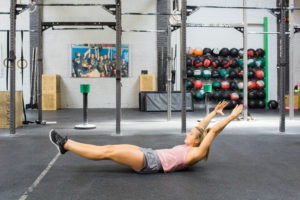
To find the bow position (also commonly referred to as the Superman position), roll to your stomach. This movement is essentially the opposite position from the hollow.
- Lay on your stomach with your arms and legs stretched out as if you were hanging from a pull-up bar.
- Contract everything on your backside – scaps, back, glutes and hamstrings – to raise your arms, chest, and thighs off the floor.
If you can establish and hold this position, then you’re in a good place to move to the next step. If not, we suggest spending more time getting into the perfect position. You can modify the position and make it a bit easier by keeping your hands at your side instead of over your head and your legs in a bent position closer into the body.
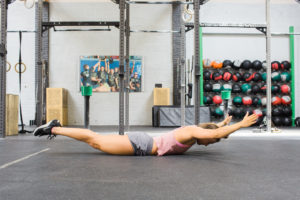
Toes-to-Bar Progression: Beat Swings
Once you’re comfortable with the hollow and bow positions, it’s time to start doing them while hanging from a bar – practicing the kipping motion by using your shoulders and lats to initiate the movement while keeping the midline tight.
If you feel like a kid swinging on the monkey bars and your kip is totally out of control, it’s because you’re attempting to kip using your legs rather than your shoulders. Think about bringing your chest forward and back rather than lifting your legs and initiating from there.
Practicing your transitions with these two movements is super important because this how you are going to generate your power, through the kip. Once you get your momentum through your hollow body and Superman, then focus on keeping your lats engaged through the swing. This will force you to continuously press down on the bar. In the superman, your chest should be in front of the bar. On the hollow body, press down on the bar so your chest is behind it and you can see in front of you.
It’s when you are in your hollow part of the kip that you should pull your knees to your chest and finish off with the toe kick that brings them to the bar. As soon as your feet hit the bar, PULL them back down as fast as possible to get back loaded up in your Superman for your next repetition.
Toes-to-Bar Tips
Tip #1 – Always keep an active hang.
As soon as you start to hang from the bar you should be in an active position, creating space between your ears and shoulders. This allows you to gain a lot of tension through your body on the rig and puts you in full control over your swing.
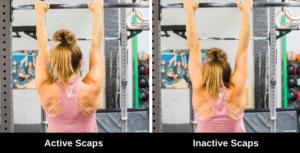
Tip #2 – Work in small sets when you are first learning.
If you can do a few toes-to-bar strung together but not a lot, stick to smaller sets and focus on perfecting your form. This will prevent you from creating bad habits when the toes-to-bar start to get challenging. Quality vs quantity.
Tip #3 – Mount the bar to initiate your swing.
Whenever you are starting your toes-to-bar, you always want to start by mounting the bar in a hollow body position. This is going to keep your body nice and long and help initiate your first kipping swing well. It will get you in the appropriate rhythm so the start of your set won’t feel like you are already 5 sets deep.
Invictus Gymnastics Coach, Travis Ewart, gives you three tips to improve your toes-to-bar starting with the “mount” to whether or not you should use straight or bent legs for the movement, depending on your personal anatomy and strengths. So if you already have toes-to-bar and are looking for ways to stay on rhythm, knock out longer sets, or tweak the movement to use different muscle groups, check this out for some tips.
How to Strengthen Toes-to-Bar
If you’re struggling with your toes-to-bar even though it seems like you should be able to do them based on your strength and athletic prowess, then read on for some tests and solutions to help you improve upon yours.
1) Weak Lower Abdominal Muscles
This is usually the first place we look for the problem and while they can be the culprit, especially in the untrained population, chances are this is actually only a small piece of the puzzle for most folks. If you have trouble with most or all abdominal/midline exercises, this is where you should first focus some attention.
Test to see if this is you by hanging from a bar and performing mini-crunches. Bring your knees to waist height without touching the floor between reps. Repeat this for AMRAP in 30 seconds. You should be able to get at least 15 reps in 30 seconds. If you cannot, you might consider putting in some extra time on your abs with any or all of these exercises to strengthen your midline.
2) Weak Shoulder Girdle and/or Lats
These are the other common culprits when it comes to strength deficiency for completing toes-to-bar. Guess what?
The shoulders aren’t just responsible for connecting our arms to our bodies, they are the first thing to activate in the toes-to-bar (and pull-up) and should continue to be active and strong throughout the entire movement not only to protect our shoulder joints but to also provide assistance in the kipping movement on the backswing and to lessen the distance our toes have to travel to touch the bar.
That first bit of shoulder activation when we hang from the bar is called a scapular pull-up and you should be able to hold that position for 30 seconds and you should also be able to do at least 10 unbroken reps of the movement.
The backswing and the toe-distance lessening are mostly controlled by strong lat muscles which allow you to push down on the bar to create a bigger, stronger kip. The stronger this portion of the swing, the higher the body travels and the shorter the distance your toes have to travel to touch the bar.
Here’s a test you can do with a partner to determine if you need to work on strengthening your lats (or just learn how to activate them). If you find that you are strong enough to do this test then great – you just needed to remind your lats of their role in all of this. But if you’re struggling to maintain the hollow position in this test, keep doing the test every day until it’s easy. You should also work more pulling exercises and static holds into your routine.
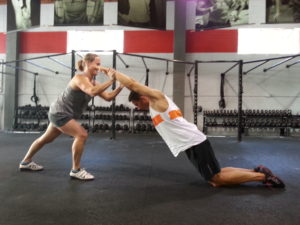
Ideas for pulling: pull-ups with varying hand grips, ring rows, DB rows, landmine rows, barbell rows, CrossOver Symmetry, hand-over-hand sled pulls, heck, you could even try swimming. Ideas for static holds: straight-arm hangs with scapular retraction, chin-over-bar holds, chest-to-bar holds, or get your lower abs and scaps at the same time with L-hangs.
3) Lack of Thoracic Mobility
This is where many people’s problems lie with toes-to-bar, pull-ups and life in general. A lot of times people mistakenly think they lack shoulder mobility (which could be the case) when it is actually thoracic mobility that is the problem.
This is the number one killer of desk jockeys because the problem can exacerbate so quickly into much larger problems – like injury or Upper Cross Syndrome – if left untreated. (see treatments).
But how do you know if this is your issue?
Here’s a test that is also a treatment meaning, if you can’t pass this (wall slide) test, keep doing it until you can. The front swing (Superman or Bow position) on the kip requires a great deal of thoracic mobility to be able to push your head and chest through so if you struggle with this portion of the toes-to-bar (or pull-up) then look here first.
If you can’t pass this test, you shouldn’t be going overhead movements with weight nor should you be kipping (jamming yourself) into a position you cannot safely achieve.
So just to be absolutely clear, if you can’t perform these you also cannot perform a safe overhead position or a safe kip so don’t get too hung up on going Rx in workouts on kipping movements until you can Rx your wall slide.
4) Timing
This is one of the places people struggle the most because they may have all of the components to stringing toes-to-bar together (including the strength) but don’t have the timing down well enough to get past the first three reps. The solution to this is how the athlete approaches the bar or the mount.
By jumping into a slightly piked shape they can grab the bar and aim their feet just forward the bar on the opposite side to get the rhythm started. It also helps to start with kipping half toes-to-bar with focus on keeping the legs straight. Some of y’all are fans of the tuck-to-kick approach to the movement but try the straight leg toes-to-bar first, then you can back off that and start tucking more as you become more fatigued.
We like this because it creates more momentum in the legs, and with said momentum, you can swing your legs higher with less physical effort.
5) Tight Hamstrings
This is the final place to look, especially if you are good to go in the four areas listed above. If your kip timing is on point and you are able to get your knees to your armpits consistently, then you should be able to do toes-to-bar. Once your knees are in your armpits, all it takes is a quick knee-extending kick to touch those toes to the bar.
So if you struggle with high-kicks in the warm-up or you can’t touch your toes, lack of hamstring flexibility is likely your demise in toes-to-bar, deadlifts, the second position in Olympic lifting and tying your shoes for time. More hamstring mashing, flossing, inch-worming, and high-kicking for you.
Chances are, you might need a little extra help from a bodyworker or yoga. Don’t forget that we are always shooting for the ultimate balance in life and athletics. So if you spend five hours per week contracting your muscles by lifting weights in the gym, you should also spend five hours stretching those muscles as well.
Just like with any sport or skill you want to improve upon, you should break down the movement to address its individual parts. This will allow you to identify weak links in your bodies and technique and address each of them separately so that when you put it all back together, you are super legit in each and every part.
Accessory Work to Improve Your Toes-to-Bar
Chinese Planks – Perform these with two benches or boxes set up perpendicular to one another. In a prone position, place your shoulders on one bench and your toes on the other. Hold for 45-60 seconds. These can also be performed in the supine position with your shoulders on one bench and your heels on the other. Try three sets of this in each direction holding for 45-60 seconds each time.
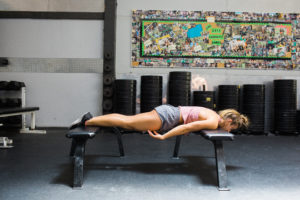
Weighted Planks – This is a plank on the ground in the prone position where someone places weight on your back. Hold this position for 60 seconds for three sets.
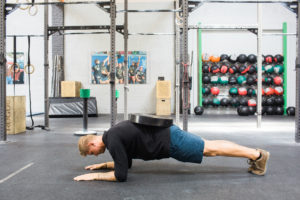
Weighted Plank with Dip Belt – Instead of placing a weight on your back, you can also perform a weighted plank by suspending a weight from your midline using a dip belt. To set this up, position different boxes next to each other with space in between for the hanging weight. Place your arms in the extended position on one box and your feet on the other – no planking on the elbows here. Hold this position for 60 seconds for three sets.
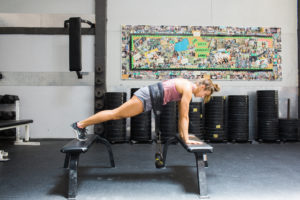
L-Sits – This movement can be done on a set of parallettes, rings or boxes. Find the hollow body position and keeping your legs straight, bring them up so that they are parallel or above the hands. Attempt to hold for 30-60 seconds. If you cannot make the full 30 seconds, accumulate time by performing the movement for a few seconds, resting, and then getting back on it.

V-Ups – Start by lying on the floor face up with your legs and arms extended in a straight line. At the same time, bring your hands and feet towards each other into a “V” position. Return to the supine position and repeat. Perform three sets of 8-10 reps.
Strict Toes-to-Bar @ 3011 Tempo – Hanging from a pull-up bar, bring your toes to the bar without kipping and bring them back down to under the bar using a three-second descent. This one can be very challenging. If you can perform this at the strict tempo, you are well on your way to connecting those toes to bar.
Pallof Press – Standing or kneeling perpendicular to a post attach a band about elbow height. With a nice strong midline and feet about hip distance apart, start by holding the band with both hands at the center of your chest. With tension on the band, push your hands away from your chest, straight ahead. Resist the urge to let the band twist you toward the post. As your hands get further away from your body the difficulty will increase. Repeat 10 times facing each direction.
Dragon Flags – Start lying on a bench with your head close to the double-leg end. Holding the bench with your hands over your head, bring your legs straight overhead and find the hollow body position. KEEPING that hollow body position, try to lower your body with your legs straight coming all the way to the floor. Repeat 3-5 times.
Add two or three of these movements to the beginning or end of your workouts and you’ll begin to see improvements in your ability to string together toes to bar in no time.
Toes-to-Bar Modifications
Don’t quite have toes to bar well enough to use them in a workout for time? Tear your hands or fatigue your grip so that toes to bar are not an option today? There are so many different variations of the toes to bar that you can use as a modification. Here are some modifications you can try:
Make sure your quads are prepped for this! This type of toes-to-bar makes for a quick cycle time but uses a ton of lat engagement. So, for workouts that are fast and are lower in toes-to-bar volume, try out this option.
Combo Swing
This swing allows an athlete to keep their straight leg for the majority of the swing but will transition to a short ‘flick’ to kick the toes to the bar. This is a great option if an athlete has good hamstring flexibility and wants to move through the toes-to-bar as quickly as possible, without fatiguing the lats as quickly as a knees-to-armpits style swing would.
Take it to the Floor
You can take it to the floor and do V-ups, tuck-ups, or straight-legged sit-ups. Keep it as challenging as you can manage to move through. Usually a 1:1 or 2:1 ratio for subbing in the movement: Toes-to-Bar.
Sometimes the neutral hand position and the give of the straps is just what you need to get those feet up there for the tap. Give these a try for something a little different!
These are a great option for those with the grip endurance who want to practice their kip swing but can’t quite get their toes to the bar, or for when touching them to the bar throws you offbeat in a timed workout. All parts of the movement remain the same except the toe kick so they are a great way to practice and still get a great workout stimulus.
These are another great option for those with the grip endurance who want to practice their kip swing but can’t quite get their toes to the bar, or for when touching them to the bar throws you offbeat in a timed workout. All parts of the movement remain the same except the toe kick so they are a great way to practice and still get a great workout stimulus!
No matter which option you choose, look at the stimulus of the workout and try to pick one that goes with it for the day. All of them are good for you and are going to benefit you in one way or another!
Toes-to-Bar Strategies for Workouts
You don’t have to be a gymnast to be good at toes-to-bar. It’s about playing your own game and knowing what you as an athlete are capable of. In any workouts, but especially competitive workouts like the Open, you want to have a plan on how to keep yourself moving continuously throughout the workout in order to achieve the highest possible score.
Here are a few different strategies you can use for toes-to-bar. Test them out to see which ones help you move the fastest and most efficiently throughout the workout.
1) Quick Sets with Short Rests
A quick set is different from athlete to athlete but what it means, no matter the rep scheme you use, is that you can knock it out and jump right back up into the next set with only a short rest in between. You know yourself best, so whether it’s sets of 8, 4, 2, have a number in your head for your sets that you know you can hit every time you reach for the bar. Clustering your reps this way is always better than doing a big set and staring at the bar for 20 seconds before you go again because, over the course of the set, you will actually spend less time on this station.
2) Singles!
There is absolutely nothing wrong with going to quick singles on any movement, toes-to-bar included. You would actually be surprised at how fast you can push through them as well as conserve energy. Whether it’s saving your lungs, grip, or just resting time in between, singles should always be something you can fall back on if your strategy from the start doesn’t go as planned. If you go with this strategy YOU MUST get back on the bar right away for your next rep – rests should be only a second, maybe two.
3) Never Go to Failure
Toes-to-bar is one of those movements that when they go, they go. Stay in your own lane, focus on you, and push yourself to your athletic abilities – not to the abilities of those around you. The last thing you want to do is burn out because that makes it harder, if not impossible, to get back up on the bar. Smart sets lead to a great performance so never push your set to the point of failing a rep or losing your kip rhythm (more on establishing rhythm below).
Toes-To-Bar Workouts
Here are a few workouts for you to get after!
1-10 unbroken toes to bar
3 sets:
Strict toes-to-bar x 8-10 @ 2110
Ring rows x 10-12 @ 2111
Rest as needed between sets
Every Minute on the Minute for 10 minutes
Min 1- 10 toes-to-bar
Min 2- 15 air squats
As Many Rounds/Reps as Possible in 12 Minutes of:
50 double-unders (or 100 single-unders)
15 toes-to-bar
10 push-ups